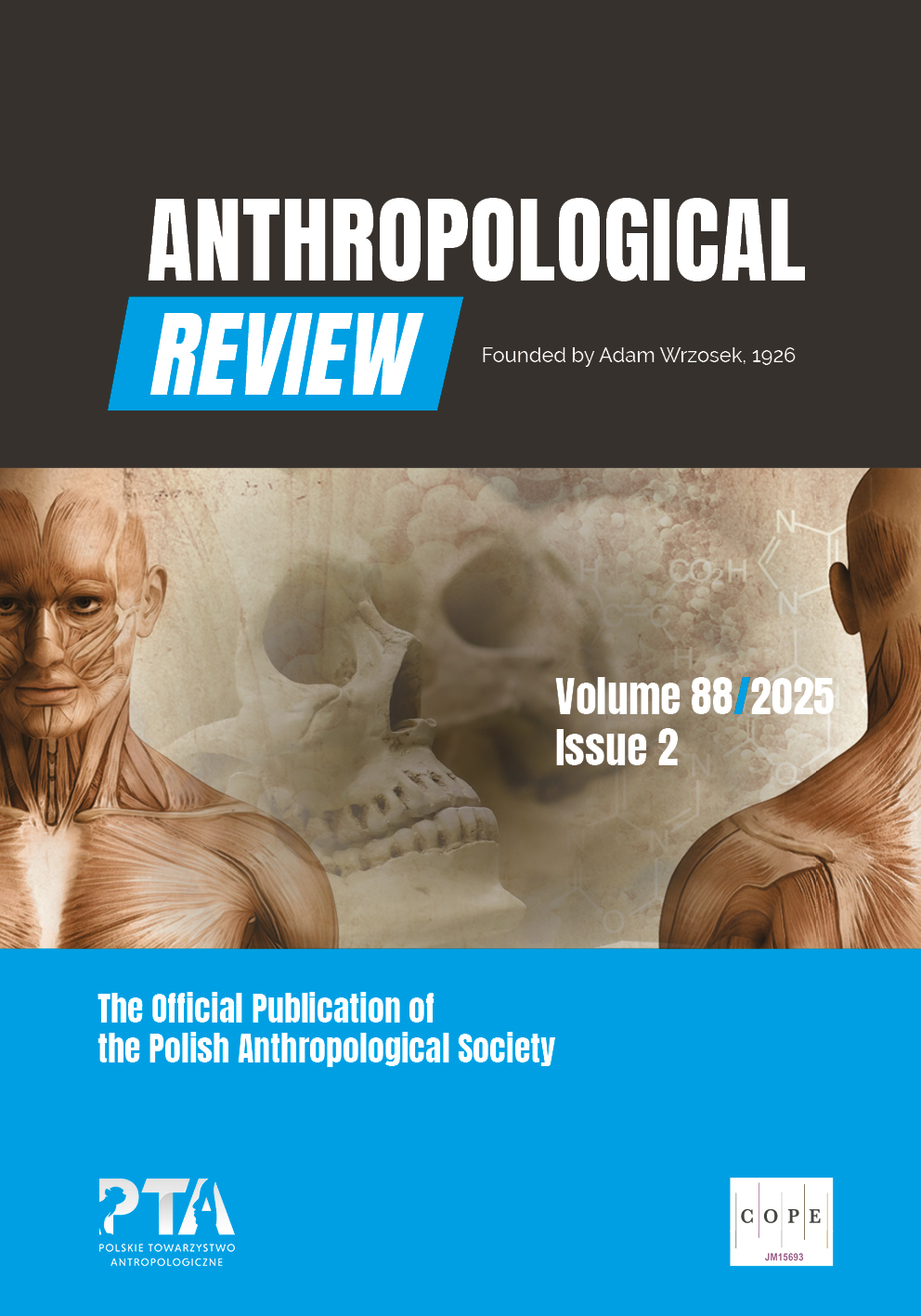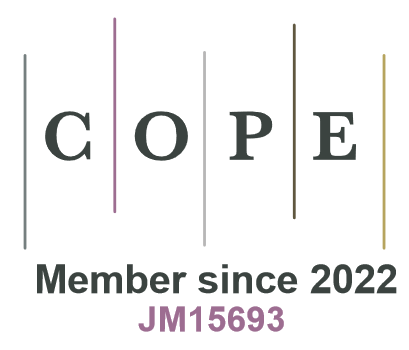Chemical Characterization of Archaeological Pulp Stones from 18th–19th Century Radom, Poland: A Pilot Study
DOI:
https://doi.org/10.18778/1898-6773.88.2.02Keywords:
pulp stones, calcium, phosphorus, mineralizationAbstract
The purpose of this study was to evaluate the calcium (Ca) and phosphorus (P) contents of pulp stones in a historical population (18th–19th centuries) from Radom, Poland. Ten molars from adults from the Radom cemetery (18th–19th centuries) were used in the study. The crowns of the teeth were mechanically opened, and visible pulp stones were examined with a scanning electron microscope equipped with a Si(Li) energy dispersive detector (energy dispersive X-ray spectrometry detector, which uses a lithium (Li)- doped silicon (Si) single-crystal semiconductor as a detector element). Enamel presented higher values of Ca/P ratio compared with the dentine and/or pulp stones. Moreover, in one case, the external layer of the pulp stone had significantly lower Ca and P contents compared with the internal layer (Ca: 13.97±0.31 vs. 34.2±0.37 [wt%]; P: 6.13±0.21 vs. 16.5±0.34 [wt%]). Evaluation of the Ca and P composition of the analyzed enamel and dentine in the Radom samples from the 18th–19th centuries produced findings that are consistent with studies conducted on teeth from contemporary populations. In the case of one individual, two chemically distinct layers were diagnosed in the pulp stone. It is difficult to interpret this finding based on a single case, but it may be due to the fact that the outer layer is characterized by higher organic structure.
Downloads
References
Al-Ghurabi ZH, Najm AA. 2012. Prevalence of pulp stone (Orthopantomographicbased). JBCD 24:80–4.
View in Google Scholar
Arnold WH, Gaengler P. 2007. Quantitative analysis of the calcium and phosphorus content of developing and permanent human teeth. Ann Anat 189:183–90. https://doi.org/10.1016/j.aanat.2006.09.008
View in Google Scholar
DOI: https://doi.org/10.1016/j.aanat.2006.09.008
Bahetwar SK, Pandey RK, Singh RK, Bahetwar TS, Wahid A. 2012. A biochemical and histopathological evaluation of generalized pulp calcification in young permanent teeth. Indian. J Dent Res 23:123. https://doi.org/10.4103/0970-9290.99062
View in Google Scholar
DOI: https://doi.org/10.4103/0970-9290.99062
Barnaś E, Chlebowska M, Hoehne T. 1972. Dentinomas. Czas Stomatol 25(12):1205–12.
View in Google Scholar
Berès F, Isaac J, Mouton L, Rouzière S, Berdal A, Simon S, Dessombz A. 2016. Comparative physicochemical analysis of pulp stone and dentin. J Endodont 42(3):432–38. https://doi.org/10.1016/j.joen.2015.11.007
View in Google Scholar
DOI: https://doi.org/10.1016/j.joen.2015.11.007
Çolak H, Çelebi AA, Hamidi MM, Bayraktar Y, Çolak T, Uzgur R. 2012. Assessment of the prevalence of pulp stones in a samples of Turkish central Anatolian population. Sci World J. https://doi.org/10.1100/2012/804278
View in Google Scholar
DOI: https://doi.org/10.1100/2012/804278
Elvery MW, Savage NW, Wood WB. 1998. Radiographic study of the Broadbeach aboriginal dentition. Am J Phys Anthropol 107:211–19. https://doi.org/10.1002/(SICI)1096-8644(199810)107:2<211::AID-AJPA7>3.0.CO;2-X
View in Google Scholar
DOI: https://doi.org/10.1002/(SICI)1096-8644(199810)107:2<211::AID-AJPA7>3.3.CO;2-5
Gaddalay S, Pathan M, Kale A, Ahhirao Y. 2015. Prevalence of pulp stones in urban and rural population of Latur Maharashtra and the challenges encountered: an endodontic perspectives. J Dent Med Sci 9:5–8. https://doi.org/10.9790/0853-14930508
View in Google Scholar
Goga R, Chandler NP, Oginni AO. 2008. Pulp stones: a review. Int Endodont J 41:457– 468. https://doi.org/10.1111/j.1365-2591.2008.01374.x
View in Google Scholar
DOI: https://doi.org/10.1111/j.1365-2591.2008.01374.x
Goldstein JI, Newbury DE, Joy DC, Lyman CE, Echlin P, Lifshin E, Sawyer E, Michael JR. 2018. Scanning Electron Microscopy and X-ray Microanalysis. New York: Plenum Press.
View in Google Scholar
Gulsahi A, Cebeci AI, Özden S. 2009. A radiographic assessment of the prevalence of pulp stones in a group of Turkish dental patients. Int Endodont J 42:735–39. https://doi.org/10.1111/j.1365-2591.2009.01580.x
View in Google Scholar
DOI: https://doi.org/10.1111/j.1365-2591.2009.01580.x
He B, Huang S, Zhang C, Jing J, Hao Y, Xiao L, Zhou X. 2011. Mineral densities and elemental content in different layers of healthy human enamel with varying teeth age. Arch Oral Biol 56:997–1004. https://doi.org/10.1016/j.archoralbio.2011.02.015
View in Google Scholar
DOI: https://doi.org/10.1016/j.archoralbio.2011.02.015
Hillson S. 1996. Dental anthropology. Cambridge: Cambridge University Press.
View in Google Scholar
DOI: https://doi.org/10.1017/CBO9781139170697
Huang LG, Chen G. 2016. A histological and radiographic study of pulpal calcification in periodontally involved teeth in a Taiwanese population. J Dent Sci 11(4):405–10. https://doi.org/10.1016/j.jds.2016.05.001
View in Google Scholar
DOI: https://doi.org/10.1016/j.jds.2016.05.001
Kaabi HH, Riyahi AM, Bakrman AK, Almutaw YA, Alrumayyan SF, Al-Maflehi NS. 2024. Pulp stones in unerupted teeth: a retrospective analysis using cone-beam computed tomography. BMC Oral Health 24:714. https://doi.org/10.1186/s12903-024-04503-3
View in Google Scholar
DOI: https://doi.org/10.1186/s12903-024-04503-3
Le May O, Kaqueler C. 1993. Electron probe micro-analysis of human dental pulp stones. J Scan Micros 7:267–72.
View in Google Scholar
Liu H-Y, Chao J-H, Chuang C-Y, Chiu H-L, Yang C-W, Sun Y-C. 2013. Study of P, Ca, Sr, Ba and Pb levels in enamel and dentine of human third molars for environmental and archaeological research. Adv Anthropol 3(2):71–7. https://doi.org/10.4236/aa.2013.32010
View in Google Scholar
DOI: https://doi.org/10.4236/aa.2013.32010
Marshall G, Verdelis K, Peters OA, 2023. Morphology of pulpal mineralizations: A scoping review. J Dent. https://doi.org/10.1016/j.jdent.2023.104745
View in Google Scholar
DOI: https://doi.org/10.1016/j.jdent.2023.104745
Milcent CPF, Da Silva TG, Baika LM, Grassi MT, Carneiro E, Franco A, De Lima AAS. 2019. Morphologic, structural, and chemical properties of pulp stones in extracted human teeth. J Endodont 45(12):1504–12. https://doi.org/10.1016/j.joen.2019.09.009
View in Google Scholar
DOI: https://doi.org/10.1016/j.joen.2019.09.009
Mirah MA, Bafail A, Shaheen S, Baik A, Zaid BA, Alharbi A, Alahmadi O. 2023. Assessment of pulp stones among western Saudi populations: A Cross-Sectional study. Cureus 15(9): e46056. https://doi.org/10.7759/cureus.46056
View in Google Scholar
DOI: https://doi.org/10.7759/cureus.46056
Mitręga J, Dreher W. 1968. Calcifying changes in the pulp. Czas Stomatolo 21(11):1325–31.
View in Google Scholar
Murray MM. 1936. The Chemical composition of teeth. IV. The calcium, magnesium and phosphorus contents of the teeth of different animals. A brief consideration of the mechanism of calcification. London: University of London.
View in Google Scholar
DOI: https://doi.org/10.1042/bj0301567
Nedoklan S, Knezovic Z, Knezovic N, Sutlovic D. 2021. Nutritional and mineral content in human teeth through the centuries. Arch Oral Biol 124:105075. https://doi.org/10.1016/j.archoralbio.2021.105075
View in Google Scholar
DOI: https://doi.org/10.1016/j.archoralbio.2021.105075
Nicklisch N, Schierz O, Enzmann F, Knipper C, Held P, Vach W, Dresely V, Meller H, Friederich S, Alt KW. 2021. Dental pulp calcifications in prehistoric and historical skeletal remains. Ann Anat 235. https://doi.org/10.1016/j.aanat.2021.151675
View in Google Scholar
DOI: https://doi.org/10.1016/j.aanat.2021.151675
Ozkalayci N, Zengin AZ, Turk SE, Sumer AP, Bulucu B, Kirtiloglu T. 2011. Multiple pulp stones: a case report. Eur J Dent 5:210–14.
View in Google Scholar
DOI: https://doi.org/10.1055/s-0039-1698882
Pach J, Regulski P, Tomczyk J, Reymond J, Osipowicz K, Strużycka I. 2023. Prevalence of taurodontism in contemporary and historical populations from Radom: a biometric analysis of radiological data. J Clin Med. https://doi.org/10.3390/jcm12185988
View in Google Scholar
DOI: https://doi.org/10.3390/jcm12185988
Palatyńska-Ulatowska A, Fernandes MC, Pietrzycka K, Koprowicz A, Klimek L, Souza RA, Pradebon M, de Figueiredo JAP. 2021. The pulp stones: morphological analysis in scanning electron microscopy and spectroscopic chemical quantification. Medicina (B Aires) 58(1). https://doi.org/10.3390/medicina58010005
View in Google Scholar
DOI: https://doi.org/10.3390/medicina58010005
Perkowski K, Marczyńska-Stolarek M, Regulski P, Tomczyk J. 2024. Characteristics of dental malocclusion in a 18th/19th century population from Radom (Poland). Int J Paleopathol 47:21–6. https://doi.org/10.1016/j.ijpp.2024.09.001
View in Google Scholar
DOI: https://doi.org/10.1016/j.ijpp.2024.09.001
Raj AC, Jayaprasad A, Manasa A, Darshan DD, Seema M, Ambili A. 2012. Correlation of pulp stone prevalence with dietary habits – A pilot study. Health Sci 1(3):JS003C.
View in Google Scholar
Robinson C, Kirkham J, Brookes SJ, Shore R. 1995. Chemistry of mature enamel. Chapter 8. In: C Robinson, J Kirkham, editors. Dental Enamel – Formation to Destruction. Boca Raton CRC Press. 167–88.
View in Google Scholar
Roomans GM. 1988. Quantitative X-ray microanalysis of biological specimens. J Electron Micr Tech 9:19–43. https://doi.org/10.1002/jemt.1060090104
View in Google Scholar
DOI: https://doi.org/10.1002/jemt.1060090104
Sakoolnamarka R, Burrow MF, Swain M, Tyas MJ. 2005. Microhardness and Ca:P ratio of carious and CarisolvTM treated caries-affected dentine using an ultra-micro- indentation system and energy dispersive analysis of x-rays – A pilot study. Aust Dent J 50(4):246–50. https://doi.org/10.1111/j.1834-7819.2005.tb00368.x
View in Google Scholar
DOI: https://doi.org/10.1111/j.1834-7819.2005.tb00368.x
Sarna-Boś K, Boguta P, Skic K, Wiącek D, Maksymiuk P, Sobieszczański J, Chałas R. 2022. Physicochemical properties and surface characteristics of ground human teeth. Molecules 27:5852. https://doi.org/10.3390/molecules27185852
View in Google Scholar
DOI: https://doi.org/10.3390/molecules27185852
Şener S, Cobankara FK, Akgunlu F. 2009. Calcifications of the pulp chamber: prevalence and implicated factors. Clin Oral Invest 13:209–15. https://doi.org/10.1007/s00784-008-0212-x
View in Google Scholar
DOI: https://doi.org/10.1007/s00784-008-0212-x
Sisman Y, Aktan AM, Tarim-Ertas E, Çiftçi ME, Şekerci AE. 2012. The prevalence of pulp stones on a Turkish population. A radiographic survey. Med Oral Patol Oral 17:212– 17. https://doi.org/10.4317/medoral.17400
View in Google Scholar
DOI: https://doi.org/10.4317/medoral.17400
Stipisic A, Versic-Bratincevic M, Knezovic Z, Sutlovic D. 2014. Metal content in medieval skeletal remains from Southern Croatia. J Archaeol Sci 46:393–400. https://doi.org/10.1016/j.jas.2014.03.032
View in Google Scholar
DOI: https://doi.org/10.1016/j.jas.2014.03.032
Tomczyk J, Komarnitki J, Zalewska M, Wiśniewska E, Szopiński K, Olczak-Kowalczyk D. 2014. The Prevalence of pulp stones in historical populations from the Middle Euphrates Valley (Syria). Am J Phys Anthropol 153:103–15. https://doi.org/10.1002/ajpa.22414
View in Google Scholar
DOI: https://doi.org/10.1002/ajpa.22414
Tomczyk J, Turska-Szybka A, Zalewska M, Olczak-Kowalczyk D. 2017. Pulp stones prevalence in a historical sample from Radom, Poland (AD 1791–1811). Int J Osteoarchaeol 27:563–72. https://doi.org/10.1002/oa.2579
View in Google Scholar
DOI: https://doi.org/10.1002/oa.2579
Turkal M, Tan E, Uzgur R, Hamidi MM, Çolak H, Uzgur Z. 2013. Incidence and distribution of pulp stones found in radiographic dental examination of adult Turkish dental patients. Ann Med Health Sci Res 3:572–76. https://doi.org/10.4103/2141-9248.122115
View in Google Scholar
DOI: https://doi.org/10.4103/2141-9248.122115
Published
How to Cite
Issue
Section
License

This work is licensed under a Creative Commons Attribution-NonCommercial-NoDerivatives 4.0 International License.
Funding data
-
Narodowe Centrum Nauki
Grant numbers 2013/11/B/HS3/04117









